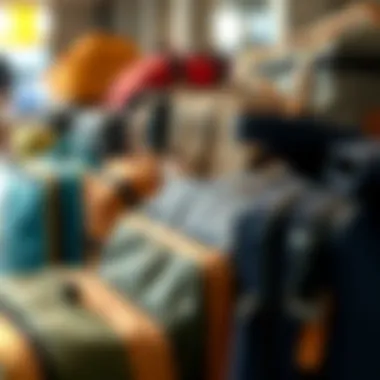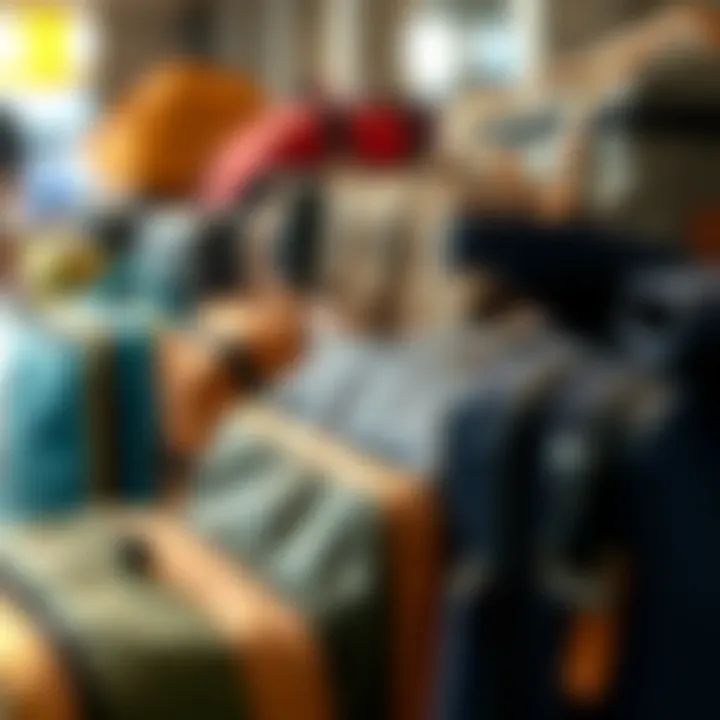Maximizing Luggage Efficiency with Space Saving Bags


Intro
Traveling can often feel like a game of Tetris, trying to fit everything into a limited space. With the evolution of packing technology, space saving bags have emerged as beneficial tools for those looking to maximize their luggage efficiency. These little wonders don't just squish clothes down; they help in organizing and keeping your items in pristine condition.
When packing for a trip, it’s essential to understand the benefits these bags can bring. Imagine fitting a week’s worth of clothing into a single carry-on—sounds impossible, right? But with the right techniques using space saving bags, it can be not only achievable but straightforward. This article dives into the various types of space saving bags available, how they function, and strategies for smart use.
Travelers, from fashion enthusiasts to outdoor adventurers, will find this discussion particularly relevant. Our analysis isn't merely about squeezing clothes into bags; it encompasses the transformative impact these products can have on luggage organization. As we explore the nitty-gritty of selecting the right bags and employing best practices, you will be better prepared for your next escapade, no matter where that leads.
By the end, you’ll have a sensible grasp of potential drawbacks as well as the perks, leading to a packing strategy that plays to your strengths and needs. So, grab your travel itinerary and let’s get into the nitty-gritty of packing smarter!
Foreword to Space Saving Bags
In an era where efficiency is paramount, the necessity of optimizing luggage cannot be overstated. As travel trends evolve, travelers are increasingly seeking innovative solutions that allow for smarter packing strategies. This leads us to the realm of space saving bags, a valuable tool that enhances the efficiency of luggage organization.
These bags serve a dual purpose: first, they condense clothing and other items, significantly freeing up space in one’s suitcase; second, they help maintain the integrity of packed garments and essentials during transit. The rising popularity of space saving bags among travelers—whether they are frequent globetrotters or occasional vacationers—can be attributed to their pivotal role in maximizing luggage capacity.
As such, an understanding of the importance of space saving bags in travel is crucial. They are not just a trend but a reflection of evolving packing strategies, tailored to meet the needs of modern-day travelers.
Definition and Purpose
A space saving bag can be defined as a storage solution designed to reduce the volume of items, primarily clothing and linens, through compression. These bags are often made from durable plastic and feature airtight seals, which allow the air to be expelled, resulting in a flat, compact package. Their purpose extends beyond mere volume reduction; they also protect the contents from moisture and dirt, making them as functional as they are space-efficient.
Using space saving bags effectively can change the dynamics of how one approaches packing. Not only do they minimize the amount of luggage needed for a trip, but they also facilitate ease of organization within bags. Travelers can effortlessly locate needed items without uprooting their entire luggage. This blend of convenience and efficiency plays a significant role in enhancing the overall travel experience.
Historical Context
The concept of compression in storage solutions is not new. However, the modern incarnation of space saving bags traces its origins back to the late 20th century when the demand for compact living spaces surged. As urbanization increased, living areas became smaller, prompting innovative thinking around storage solutions.
In the early days, compression methods were somewhat rudimentary, often involving simple manual squeezing to remove air. With advancements in material sciences and design, the modern space saving bag saw the light of day. Marketed heavily in the early 2000s, these bags gained traction among travelers who were keen to make the most of their packing capabilities.
Today, space saving bags are tailored to fit a variety of needs and preferences, from lightweight travel bags designed for quick trips to heavier-duty options meant for bulky winter apparel. Understanding their evolution provides insight into how they have become integral in today’s packing solutions, reflecting a broader trend towards maximizing the efficiency of travel and lifestyle.
Types of Space Saving Bags
When it comes to effective packing, understanding types of space saving bags is crucial. These bags offer distinct advantages tailored to various needs, making them an essential tool for travelers looking to maximize every inch of luggage space. Each type caters to specific packing scenarios, and selecting the right one can streamline the whole packing process while also safeguarding your clothes.
Vacuum Seal Bags
Vacuum seal bags are often hailed as the top contenders in the world of space-saving solutions. They work by removing air from the bag, which significantly reduces the volume of the contents. This not only saves space in your luggage but also protects garments from moisture and pests.
One of the standout features is their ability to compress bulky items like jackets and blankets. When these bags are not in use, they can be folded flat, making them easy to tuck away in a drawer or cupboard.
The convenience of vacuum seal bags is particularly beneficial in certain travel scenarios - for instance, if you're going on a ski trip. You can easily fit multiple winter outfits without taking up too much room. Moreover, keeping clothes in a vacuum-sealed state can preserve their condition longer, an appealing factor for anyone who enjoys wearing high-quality fabrics.
Compression Bags
Moving on, compression bags provide another robust option for travelers. Unlike vacuum seal bags, these rely on a simple design - you roll or push out air through a one-way valve without the need for electric pumps. This makes them more user-friendly for those who prefer simplicity in their travel gear.
Compression bags are particularly effective for soft items like t-shirts, sweaters, and sleeping bags. The strategy here is to fold the clothing efficiently and squeeze out excess air, allowing them to fit snugly into your suitcase or backpack.
These bags often come in various sizes, letting travelers customize their packing process based on trip duration and clothing needs. They can be excellent for weekend getaways or long-term trips, ensuring you can bring all the outfits while still adhering to luggage limits.
Foldable Bags
Last but not least, we have foldable bags. These are multifunctional and can serve various purposes beyond just a space-saving application. When you’re not using them, they can be compressed into small pouches, making storage a breeze.
Foldable bags are great for day trips or as backup storage for souvenirs and purchases made during travel. Their lightweight nature ensures they don't add significant weight to your luggage, yet they provide a viable option for carrying extra items without hassle.
In addition, many foldable bags come water-resistant, making them suitable for diverse climates and situations, whether you're hitting urban streets or exploring rural terrains.
In summary, knowing the types of space saving bags allows travelers to choose the right fit for their specific needs, ensuring packing is both efficient and effective.
To wrap it up, whether you lean toward vacuum seal bags for their extreme compression, compression bags for their ease of use, or foldable bags for their versatility, understanding the strengths of each type will set the stage for a smarter packing experience.
Advantages of Using Space Saving Bags
In the realm of travel, the quest for efficient luggage management is unending. Space saving bags play a crucial role in the packing process, offering distinct benefits that not only enhance the amount of items one can carry but also the overall travel experience. This section sheds light on how these clever tools can streamline packing efforts, safeguard belongings, and promote organized travel routines.


Enhanced Packing Efficiency
One of the standout qualities of space saving bags is their ability to drastically improve packing efficiency. Imagine trying to stuff clothes into your suitcase, only to realize that the more you squeeze, the less fit they seem. This is where space saving bags come into play. They compress your garments to a fraction of their size, making seemingly impossible packing scenarios manageable.
Using these bags allows travelers to maximize their suitcase space, leaving room for those essentials that might have otherwise been left behind.
- Saves Space: Whether you are a minimalist or someone who believes in being prepared for every occasion, space saving bags help fit more items efficiently.
- Versatile Usage: They are not just for clothes; towels, blankets, and even shoes can be packed neatly.
- Convenience: With a quick roll or zip, you can condense a pile of clothing to fit neatly within your bag.
When you're looking to optimize every inch of your luggage, the compression offered by these bags transforms how much you can travel with in a single trip.
Protection for Clothing
Another significant advantage of space saving bags is their protective qualities. When traveling, especially to varied climates or remote locations, the last thing anyone wants is damaged, wrinkled, or dirty clothes.
- Minimizes Wrinkles: Compression techniques help keep your clothes flat and wrinkle-free, making them ready to wear straight from the suitcase.
- Dust and Moisture Resistant: Many space saving bags are designed to keep moisture and dust at bay, safeguarding your clothing quality.
- Secure Storage: They offer a barrier against spills or unexpected mishaps, giving the user peace of mind that their attire is safe.
Travelers can arrive at their destinations with clothing in pristine condition, enhancing the overall experience and reducing laundry on the go.
Organization and Accessibility
Lastly, organization cannot be overstated when discussing the advantages of space saving bags. A well-organized packing system not only saves time but also minimizes stress during travel.
- Separation of Items: By using different bags for various categories, like one for formal wear and another for casual attire, you create an easy system to access your belongings.
- Quick Access: When time is of the essence, knowing where everything is can make or break your trip.
- Visual Clarity: Transparent designs give you visibility over contents without rummaging through bags, saving precious time.
"Hurry up and wait" is a common travel phrase; however, with the right organization, travelers can find what they need without excessive delays.
In summary, the importance of space saving bags in travel hinges on their ability to enhance packing efficiency, protect garments, and promote an organized strategy that subsequent travelers can greatly benefit from. With these bags, the world is indeed your oyster.
Selecting the Right Space Saving Bag
Choosing the right space saving bag is crucial for travelers who wish to pack efficiently and maximize the space in their luggage. The diverse array of space saving bags on the market can make this choice a daunting task, but understanding some key elements can ease the selection process. Each traveler has unique needs based on their packing style, type of trip, and even the climate they’re heading towards. When one is selecting a space saving bag, several considerations become essential to ensure that the bag not only fits the traveler's needs but enhances their overall packing strategy.
Size Considerations
Size isn’t just a number; it’s the lifeblood of effective packing. Different trips require different sizes of space saving bags, so it’s wise to consider how much you intend to pack. A weekend trip may call for smaller bags, say the 12-inch by 16-inch compressors that can neatly store a couple of outfits and a pair of shoes. Alternatively, long vacations might necessitate much larger options, like those bags that stretch to 24 inches or more, accommodating bulkier clothes or seasonal gear like jackets.
- Visualize Your Packing: Before diving into purchase decisions, visualize what you will pack. Measuring your suitcase or backpack can also help in selecting bags that will fit without issues.
- Versatility Matters: Opt for products that come in a range of sizes or are expandable. This way, regardless of the packing situation, you’re well covered.
Material Durability
When it comes to packing products, durability can’t be overlooked. Space saving bags are meant to withstand squeezing and squishing into tight spaces. Thus, they should ideally be made from robust materials like high-density polyethylene or nylon. These materials not only ensure that the bags won't easily tear or rip when under pressure but also contribute to waterproof capabilities, keeping your clothing safe from spills or damp environments.
- Assess the Thickness: Thicker bags tend to last longer. Evaluating the thickness of the material can be a good indicator of durability.
- Check for Seams: Strong seams are fundamental. Double-stitched seams often indicate that the bag can handle a bit more strain than a standard single stitch.
Closure Mechanism
The closure mechanism of space saving bags plays a significant role in their effectiveness. You wouldn’t want to find your belongings scattered all over your suitcase due to a faulty zipper or a defective seal. Many bags today utilize versatile and reliable closure techniques that maintain the integrity of the compression. Some are equipped with zippers, while others utilize a roll top or velcro seals.
- Zipper vs Roll-Top: It’s usually a matter of preference. Zippered bags can provide a tighter closure, while roll-tops offer a degree of adjustability depending on the amount of contents.
- Lock Systems: Some bags even come with locks or features preventing accidental opening. Consider whether this feature might be beneficial for your travels.
"Selecting the right space saving bag isn't just about fitting into your suitcase; it’s about creating an organizational system that works for you. The right choice can ease the stress of travel, making the experience far more enjoyable."
In the end, taking the time to select space saving bags that align with your packing style, needs, and travel scenarios pays off. The right bags can be game-changers, ensuring your next adventure is filled with enjoyment rather than the hassle of managing luggage.
For more tips on travel packing and bag selection, consider checking out resources like Wikipedia and Reddit for community discussions.
Best Practices for Using Space Saving Bags
When it comes to using space saving bags, a few best practices can really make the difference between a smooth journey and a packing nightmare. Knowing how to properly fill, seal, and store these bags is essential for maximizing efficiency and ensuring that your belongings remain in pristine condition throughout your travels. With these techniques, travelers can learn to avoid common pitfalls and make the most out of every inch in their luggage.
Filling Techniques
The first step in the journey toward effective packing starts with filling your space saving bags correctly. It's not just about stuffing in clothes haphazardly; there's a bit of finesse involved.
To ensure that you take full advantage of the space in these bags, consider the following:
- Roll Clothes: Instead of folding your garments, roll them. This method not only saves space but also minimizes wrinkles, keeping your attire looking fresh when you reach your destination.
- Layer Strategically: Place heavier items, like jeans or jackets, at the bottom of the bag, and lighter items, such as shirts, on top. This helps to balance the load and keeps the shape of the bag intact.
- Fill Gaps: Use small items like socks or accessories to fill any gaps within the bag. This tactic can greatly enhance space efficiency, making sure you don't leave any unused air pockets.


Using these basic filling techniques helps you play Tetris in your luggage, leaving you with extra room for those souvenirs you might pick up along the way.
Sealing Methods
Sealing mechanisms can vary between different types of space saving bags, but proper sealing is crucial no matter which type you choose. A good seal protects your belongings from moisture and pests while also ensuring that the compression truly works as intended. Here are some tips:
- Check the Seal: Ensure that the zipper or the sealing mechanism is functioning properly before sealing. A faulty seal could allow air back in and ruin all your efforts.
- Use Air Pumps for Vacuum Bags: If you're using vacuum seal bags, invest in a small hand pump or an electrical pump. This tool efficiently removes air, creating a tighter seal. It’s far more effective than trying to suck the air out with your lungs.
- Double Check After Packing: Sometimes things shift during the packing process. Don’t hesitate to reopen the bag just to make sure everything is still sealed tight. Once you hit the road, you don’t want to realize you’ve left a small opening for air to sneak back in.
Storage Strategies
Now that you’ve effectively filled and sealed your space saving bags, the next step is to store them properly within your luggage. This part might sound straightforward, but a little planning can go a long way:
- Create a Packing Layout: Before you start placing bags into your suitcase, visualize how and where each will fit best. Large bags can act as a base, while smaller ones might nest neatly on top.
- Use Packing Cubes: If you’re an organization aficionado, pairing space saving bags with packing cubes can optimize your luggage space even further and keep items from getting mixed up.
- Distribute Weight Evenly: As you place the bags in your suitcase, balance the weight evenly. This helps avoid awkward bulk that can lead to discomfort when lugging your luggage around airports or train stations.
By implementing these strategies and techniques, travelers can ensure that their experience with space saving bags is nothing short of exemplary. Not only do these methods help make packing more efficient, but they also enhance the overall travel experience by reducing the stress often associated with luggage management.
"A traveler is often judged by the quality of their packing."
Clearly, mastering the best practices for using space saving bags not only enhances your packing experience but also leaves a lasting impression on those you encounter in your journey. (0, 3)
Potential Drawbacks of Space Saving Bags
While space saving bags can be a game-changer for travelers aiming for organization and efficiency, they do come with a few potential downsides worth considering. Understanding these limitations can help travelers use these bags wisely and maximize their benefits without falling prey to their drawbacks.
Risk of Overpacking
One of the most significant risks associated with the use of space saving bags is the tendency to overpack. With the reduction in volume these bags offer, it's all too easy to get carried away, stuffing more items than originally planned. This phenomenon may lead to a few issues:
- Weight Restrictions: Airlines have strict weight limits for luggage. An innocent intention to pack 'just one more sweater' can suddenly lead you into that dreaded weight-overage fee.
- Accessibility Issues: If every nook and cranny of your space saving bag is crammed full, it can be challenging to find what you actually need while on the go. Imagine digging through layers of clothing to find that one pair of shoes at the bottom—frustrating, right?
- Physical Strain: Carrying a bag that's heavier than necessary can lead to back strains or shoulder aches, making your travel experience less enjoyable.
In short, in the quest to optimize space, it can become all too tempting to toss in extra items, which can backfire. Setting limits and sticking to a packing list is crucial to maintain balance and prevent the pitfalls of overpacking.
Wear and Tear Factor
Another issue worth mentioning is the wear and tear associated with space saving bags. These tools, while practical, can suffer from durability issues over time. Here are a few points to mull over:
- Material Weakness: Some space saving bags are made from thinner materials to facilitate the compressing process. This can make them more prone to puncturing or tearing, especially if they hold sharp objects like zippers or jewelry.
- Seal and Closure Failure: Over time, the seals on space saving bags can degrade. Once they lose their efficacy, not only do they fail to keep air out, but they can also allow moisture to seep in, which isn’t ideal for those lovely clothing pieces you hoped to protect.
- Long-Term Usage concerns: If you’re using these bags frequently or traveling often, you might find yourself replacing them more often than anticipated. Not exactly cost-effective.
So, while space saving bags may seem ideal for packing, it’s crucial to consider the risks of overpacking alongside the wear and tear that may accumulate. Knowledge is power—travelers need to be aware and act prudently to enjoy hassle-free adventures.
Travel Scenarios for Optimal Use
Understanding the role of space saving bags across various travel scenarios is critical for optimizing luggage efficiency. Different types of travel come with distinct challenges and needs. Recognizing these nuances allows travelers to choose the right space saving solutions and utilize them effectively. Space saving bags are not just an accessory; they're a game changer, making it easier to pack smart for business trips, family outings, or thrilling adventures. Let's unravel how each scenario benefits from using these bags.
Business Travel
When it comes to business travel, packing efficiently is not just about fitting in more clothes; it’s about maintaining a polished appearance while bringing along all necessary essentials. Space saving bags are exceptionally useful in this context as they help professionals streamline their packing process.
Travelers can benefit from compression bags that minimize the bulk of suits, dress shirts, and ties. By compressing outfits, one can fit in more professional attire without sacrificing quality. Additionally, travelers can utilize vacuum seal bags for items like shoes or toiletries, ensuring they are packed neatly and securely. Timing is often tight for business trips; using these bags allows for faster packing and unpacking, which means more time for meetings and less time fumbling with luggage.
"Time lost is never found again," so maximizing every minute of a business trip is paramount.
Family Vacations
Family vacations are often filled with a variety of items that need careful consideration for packing. From clothing for different activities to toys and snacks for children, families can quickly find themselves overwhelmed. Here, space saving bags serve as lifesavers as they can help segregate families’ needs efficiently.
For instance, foldable bags can be a game changer during trips to the beach or mountains, allowing families to pack swimwear and hiking clothing separately. Each member can have their own set of clothing rolled neatly into space saving bags, making retrieval a breeze. By clearly labeling the bags, finding and organizing family gear becomes much easier, preventing the common chaos that arises from digging through suitcases. Parents can also leverage these bags to protect clothing from spills and messes made by their little ones, ensuring that everything remains fresh and clean throughout the trip.
Adventure Travel
For adventure travelers, packing light yet smart can sometimes feel like packing for a small army. Space saving bags fit perfectly into this scenario, supporting travelers who need versatile gear to cover a range of terrains and climates.
Using vacuum seal bags can enable adventure seekers to tightly pack clothing needed for varied conditions, from tropical climates to potential mountain chill. Each item tightly packed translates to more room for equipment—be it camping gear, climbing tools, or diving kits. Additionally, it’s crucial to have the right protection for these items from moisture. With some space saving bags being waterproof, they can ensure that essential gear remains dry, even in unexpected rain.
Ultimately, understanding the unique needs of every travel scenario can greatly enhance the travel experience. Space saving bags are effective tools that cater to diverse requirements—whether it's looking sharp in a boardroom, enjoying a family road trip, or exploring nature’s rugged terrains.
Environmental Considerations


When travelers consider various packing techniques, the environmental impact of their chosen materials often goes unnoticed. Space saving bags, while providing efficiency in luggage packing, can also feature characteristics that align with eco-conscious practices. These materials and their handling after usage have significant implications for our planet's health.
Sustainability of Materials
One of the crucial aspects of space saving bags is the sustainability of the materials used in their construction. Many bags are made from plastics, which can contribute to environmental degradation if not handled properly. However, several manufacturers are shifting towards biodegradable and recyclable materials. These options reduce the ecological footprint.
For example, some brands are now using materials derived from recycled plastics or bio-based sources. By supporting products developed with sustainability in mind, travelers not only benefit from enhanced packing efficiency but also contribute to a greener planet. This dual benefit cannot be overstated in an age where environmental responsibility is paramount.
Recycling Options
Post-use management of space-saving bags also deserves consideration. Travelers often find themselves discarding these bags after their initial use, which can lead to a significant accumulation of waste. However, the recycling landscape is evolving, giving consumers alternatives. Many communities and companies are establishing programs focused on recycling plastics.
Travelers can also look for programs that accept space saving bags specifically. For instance, participating in initiatives offered by retailers like Target and Walmart or local recycling centers can ensure these bags are disposed of responsibly. Options for recycling include:
- Returning to retail: Some stores have recycling bins specifically for plastic products.
- Contacting the manufacturer: Certain companies offer take-back programs allowing consumers to return bags for proper recycling.
- Creative repurposing: Sometimes, bags can be used for storage in the home, keeping them in circulation rather than tossing them.
Both sustainability of materials and recycling options highlight the dual responsibility of consumers and manufacturers in mitigating environmental impact. Acknowledging these factors enables travelers to maximize the efficiency of their luggage while also honoring a sustainable modus operandi.
Consumer Reviews and Feedback
Understanding consumer reviews and feedback adds a crucial layer to the discourse on space saving bags. In the world of travel accessories, first-hand experiences from fellow travelers are invaluable. These insights can illuminate the practicalities of using certain products, far beyond what manufacturers may declare in their marketing.
User Experiences
When people set off on their journeys, the last thing they want is for their carefully selected packing systems to fall flat. User experiences often highlight both the triumphs and pitfalls of utilizing space saving bags. For instance, many users rave about the remarkable compression offered by vacuum seal bags, which dramatically increases the available luggage space. They often describe the ability to fit an entire wardrobe into a modest luggage compartment as a game changer.
Other travelers provide warnings about choosing lower-quality products. Frustrating tales abound of bags that lost their seal amidst the chaos of airport transfers, causing clothes to expand and occupy more room than intended. Furthermore, stories frequently surface regarding the effectiveness of closure mechanisms—a common pain point. Users may swear by bags that feature zippers instead of the older-style seals, claiming they hold better under pressure.
"I never thought I could fit a week's worth of clothes into my carry-on, but these bags made it happen. Just be careful with the seals; I had one burst during a trip and it was a mess!"
— Faith J., frequent traveler
Without a doubt, sharing experiences can guide potential buyers towards making informed decisions and avoiding common traps. With this feedback, travelers can better select bags that genuinely fulfill their needs rather than relying solely on advertisements.
Expert Opinions
In addition to users, expert opinions represent another layer of credibility. Professionals in travel and fashion often test products repeatedly before making recommendations. Their analyses can help sift through the plethora of options available on the market.
Experts frequently comment on the importance of materials used in space saving bags. For example, some emphasize the need for durable materials that resist wear and tear over time. They might suggest bags made from high-quality nylon or polyester, which can withstand the rigors of travel.
Additionally, travel gurus often discuss the environmental impact of products and whether brands are using sustainable practices in sourcing materials. A recommendation from an expert can not only save time for consumers but also direct attention to brands committed to quality and sustainability.
Finale and Future Outlook
The exploration of space saving bags serves to highlight their integral role in enhancing travel experiences through organized packing. In assessing the advantages of these innovative products, we see not just a means to an end but a transformative approach to how we manage luggage. The ability to streamline belongings, while maximizing available space, reflects significant practical benefits for travelers of all kinds.
Recap of Key Points
- Efficiency in Packing: Space saving bags allow travelers to compress clothing, reducing overall volume, which means more room for other essentials. For instance, using compression bags can often cut the volume of bulky sweaters by nearly half, creating additional space.
- Protection for Goods: Besides giving more room, these bags also offer protection against spills and wrinkles, which is invaluable during multi-leg journeys. The peace of mind that comes from knowing expensive or sentimental clothing is safeguarded cannot be understated.
- Organization: Effective use of space saving bags also enhances organization. By categorizing garments into different bags, one can quickly access what's needed—whether it's a formal outfit for a business meeting or casual wear for a day out.
- Adaptability: Different types of bags cater to varied travel needs, from vacuum-seal bags for longer trips to foldable bags for quick getaways. This versatility means that there's likely a suitable option for every travel scenario.
- Environmental Considerations: With sustainability being a major concern, many brands are now focusing on eco-friendly materials for space saving bags, allowing conscious consumers to travel with a lighter footprint.
Emerging Trends in Packing Solutions
The future of packing solutions is bright, with emerging trends poised to revolutionize how we think about travel and organization. Here are a few noteworthy points to consider:
- Smart Technology Integration: Advances in technology are leading to the development of smart luggage, often equipped with built-in sensors. These extras can alert users if the maximum weight limit is reached, promoting better packing habits.
- Customization and Personalization: Consumers are increasingly looking for customized solutions. Brands that offer personalization options, such as color choices or monogramming, are gaining traction. This adds a personal touch while enabling efficient packing.
- Sustainable Practices: As discussed previously, sustainability remains a key trend. More companies are opting for recyclable materials and sustainable production practices, which gives environmentally conscious travelers additional options.
- Compact Design Innovations: New designs that incorporate compression technology without the need for excess tools or vacuums are emerging, bringing better convenience to the user experience.
Links to Buying Guides
When it comes to selecting the right space-saving bags, having a solid buying guide can save you the headache of trial and error. An effective buying guide outlines the characteristics to look for and helps you navigate through the maze of options available in the market. Here are some aspects covered in these guides:
- Material Quality: Understanding which materials provide durability while ensuring ease of use.
- Size and Capacity: Guidance on selecting the appropriate size based on your travel needs.
- Price Range: Insights on finding quality products without breaking the bank.
- Brand Recommendations: Trusted brands known for their reliability and innovation in travel gear.
You might want to check out links like Consumer Reports or Wirecutter for in-depth reviews and recommendations on various packing solutions. Having this type of resource can protect your investment and ensure you make informed choices.
Further Reading on Travel Packing Techniques
Expanding your understanding of travel packing techniques can profoundly impact your packing efficiency. Multiple readers might find that traditional packing methods just don't cut it anymore—especially when trying to fit that extra pair of boots or a winter jacket into a small suitcase. Dive into some insightful articles, blog posts, and research papers that cover:
- Innovative Packing Methods: Techniques such as the rolling method versus folding clothes and using packing cubes alongside space-saving bags.
- Step-by-Step Guides: Detailed methods walking you through how to effectively pack for business trips, family vacations, or even long-term travel.
- Travel Hacks: Unique strategies that seasoned travelers use to maximize every square inch of their luggage.
For additional reading, resources like The Travel Hack or Skip Packing provide excellent content on packing tips and tricks. Consider exploring sites that focus on lifestyle and travel planning to uncover lesser-known, effective techniques.
"Knowledge is the new currency in travel; the more you know, the less you have to carry."
In summary, additional resources in the form of buying guides and further reading on travel packing are absolutely pivotal for travelers who wish to maximize luggage efficiency. By tapping into these resources, one can not only enhance their packing skills but also navigate the complex landscape of travel with ease.















